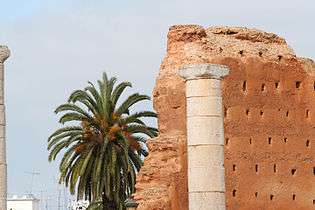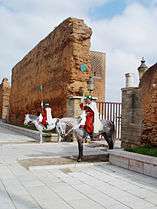Hassan Tower
Coordinates: 34°01′26.98″N 6°49′22.17″W / 34.0241611°N 6.8228250°W

Hassan Tower or Tour Hassan (Arabic: صومعة حسان) is the minaret of an incomplete mosque in Rabat, Morocco.[1] Begun in 1195, the tower was intended to be the largest minaret in the world along with the mosque, also intended to be the world's largest. In 1199, Sultan Yacub al-Mansour died and construction on the mosque stopped. The tower reached 44 m (140 ft), about half of its intended 86 m (260 ft) height. The rest of the mosque was also left incomplete, with only the beginnings of several walls and 200 columns being constructed. The tower, made of red sandstone,[2] along with the remains of the mosque and the modern Mausoleum of Mohammed V, forms an important historical and tourist complex in Rabat.

Instead of stairs, the tower is ascended by ramps. The minaret's ramps would have allowed the muezzin to ride a horse to the top of the tower to issue the call to prayer.
Yaqub al-Mansur
Founder of the Hassan Tower, Yaqub al-Mansur was a member of the Almohad Caliphate, a Berber Muslim empire in the Maghreb and Iberia. The tower, according to some traditions, was designed by an astronomer and mathematician named Jabir ibn Aflah who was also supposed to have designed Hassan's sister tower, the Giralda of Seville in Al Andalus (modern day Spain). Both of the towers were modeled on the minaret based on the Koutoubia Mosque in Marrakech. Jabir's involvement in the design of the structure can not be confirmed though and many scholars assume that the tower was designed by Ahmad Ben Basso, the designer of the Koutoubia Mosque. Spanish Renaissance later added a belfry on top of the Giralda, which was converted from a minaret to a bell tower for the Seville Cathedral after the Reconquista.
Yaqub al-Mansur conducted other works in Rabat, most notably reconstruction of the Kasbah of the Udayas and conversion of the Chellah ancient complex, built by the Phoenicians and Romans,[3] to a necropolis usage.
World heritage status
This site was added to the UNESCO World Heritage Tentative List on July 1, 1995 in the Cultural category.[4] It was granted World Heritage Status in 2012. [5] [6] [7]
Gallery
 Remnants of wall at Hassan Tower, Rabat, Morocco
Remnants of wall at Hassan Tower, Rabat, Morocco Wall at Hassan Tower, Rabat, Morocco
Wall at Hassan Tower, Rabat, Morocco View of Rabat from Hassan Tower plaza, Morocco
View of Rabat from Hassan Tower plaza, Morocco Guards at Hassan Tower, Morocco
Guards at Hassan Tower, Morocco
See also
References
| Wikimedia Commons has media related to Hassan Tower. |
- ↑ Encyclopædia Britannica online
- ↑ William A. Hoisington, Lyautey and the French Conquest of Morocco, 1995, Palgrave Macmillan, 292 pages ISBN 0-312-12529-1
- ↑ "Chellah" C.Michael Hogan, The Megalithic Portal, ed. Andy Burnham
- ↑ Tour Hassan - UNESCO World Heritage Centre
- ↑ "Rabat, Modern Capital and Historic City: a Shared Heritage". UNESCO. 2012. Retrieved 2013-10-06.
- ↑ "Rabat". World Heritage Site. September 2013. Retrieved 2013-10-06.
- ↑ "Rabat Named UNESCO World Heritage Site". Caribbean News Digital. 2012-11-23. Retrieved 2013-10-06.